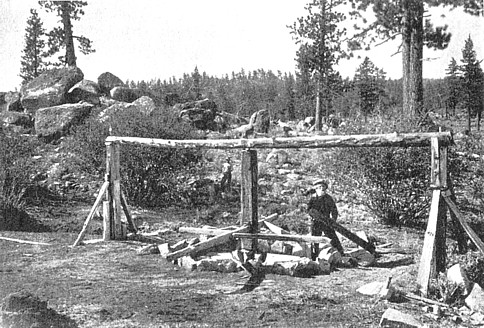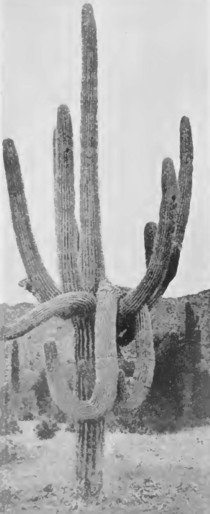About this time Henry Wickenburg discovered and located what was afterwards known as the Vulture Mine, a ledge of about forty feet wide, having a chimney of ore five hundred feet in length, the ores of which averaged about forty dollars a ton, and another chimney about six hundred feet in length, of about the same width, the ores of which ran about fifteen dollars a ton. These chimneys were worked to a vertical depth of about a hundred and seventy feet on the vein, and many millions of dollars were taken out. The opening of these gold mines in Central Arizona, accounts of which, no doubt greatly exaggerated as they were reproduced in San Francisco and again in the East, were probably the incentive to Congress to organize at once the Territory of Arizona. The country, at that time, needed gold and silver to meet its war expenses, and our statesmen in Washington, no doubt became convinced that Arizona was a country worthy of reclamation and redemption from savagery. The excitement attendant upon the discovery of these diggings drew into the Territory a large immigration, sufficient, in a way, to protect themselves from their Indian foes, which they had to do because the military, with the exception of a small guard at Tucson and Fort Mohave, was withdrawn from Arizona into New Mexico, and all the Indian tribes, with the exception of the Papagoes, Pimas, Maricopas and Yumas, were upon the warpath.
Much has been mentioned about the discovery of the Vulture Mine, and this mine, as old residents of Arizona know, had some very varied experiences. After Henry Wickenburg, its discoverer, had managed to get the first ton of the ore packed into his camp in 1864, and ground, he sold to anyone who would put up an arrastra, the ore for $15 a ton, the buyer mining and sorting the gold ore himself. During the years 1865 and 1866, there were four mills built within less than one mile of the present town of Wickenburg ; one a five-stamp mill, built by Charles Tyson, another a five-stamp mill built by Jack Swilling at the place where F. H. O'Brien afterwards owned a ranch ; another a ten-stamp mill, and the fourth a twenty-stamp mill, half a mile above the present town of Wickenburg. This last mill was run two years when twenty more stamps were added, after which it was run until 1871. James Cusenberry built the twenty-stamp mill, and also added the twenty more stamps. He turned the management over to a man named Sexton, who ran it into the ground, and was over one hundred thousand dollars in debt in Arizona in 1871, when he had to close down. C. B. Genung, says that it is hard to tell exactly how much the Vulture owed in California at that time, and that it is doubtful if any of those debts were ever paid.
The ten-stamp mill was owned by Wm. Smith, Fritz Brill and others, and was moved from Wickenburg to a point about thirteen miles down the Hassayampa, in order to get wood, as the wood had all been consumed near the town. This mill was run until 1878 and 1879, when Smith & Company sold out, their claim and hold on the Vulture reverting to James Seymour of New York, who had bought the old Wickenburg interests. Seymour employed James Cusenberry to superintend the working of the property, and he moved twenty stamps of the old mill down to a point on the river about eleven miles below, and the twenty stamps were run at the place which was called ''Seymour" for nearly a year, when a man named Shipman was put in charge. Instead of moving the other twenty stamps to Seymour, he advised the building of a larger mill at the mine and pumping the water from the river to it. The result was an eighty-stamp mill, and a seventeen mile pipe-line to it. It was not worked to any extent until 1912, when the property passed to a Canadian company. R. C. McCormick, the Secretary of the Territory, afterwards Governor, and then delegate to Congress, probably did more for the advancement of the Territory than any other one man. He was enthusiastic as to the possibilities of Arizona, as more than one of his letters to the eastern papers are evidence.
In a previous chapter I gave one of his
letters to the *'New York Tribune," which was designed to give publicity to
the Territory. Mr. McCormick was not only an enthusiastic believer in the
possibilities of Arizona, but was a student of national affairs, as the
following letter, dated June 20th, 1865, will show:
"To the Editors of the Journal of Commerce: "Your editorial headed 'Safety
Valves for Superfluous Pugnacity,' suggests a matter worthy not only of the
consideration of our now unemployed volunteers, but also of the government.
"Just as California offered a safety valve for the superfluous fighting
element of the country after the Mexican War, so the territories which have
recently been proved to be equals of California in metallic wealth, offer
the desired opportunity for working off the excess of pugnacity which
survives the great Rebellion. We do not mean to say that the discharged
soldiers who migrate to the territories will have much fighting to do. There
will be a taste of it occasionally in scaring off the hostile Sioux,
Pah-Utes or Apaches. This, with hunting and other wild sports, will enable
them to keep up something of their rifle practice. But the excitement of the
territorial life will consist principally of prospecting for, and working
mines, and contending with the natural difficulties of the new and almost
unexplored land. As the chances for making a fortune will be great, so the
obstacles to be overcome will be forbidding to all but strong arms and
hearts such as American soldiers have carried through the four years war.
There could have been no better school than this work to educate men to
grapple with the problems of a miner's life.
In those early days Wickenburg was an adobe hamlet of perhaps two hundred inhabitants, depending chiefly on the Vulture mine. Here the party halted for two or three days to rest and recruit, which afforded them an opportunity to visit the mine. The General reports it as follows: "It is really a fine specimen of native gold bearing quartz, off in the mountains, some fifteen miles west of Wickenburg, whence the ore was then wagoned to the mill, on the Hassayampa at Wickenburg. It consists of a fine vein of free quartz, from five to fifteen feet wide, and mostly devoid of sulfides, or other refractory substances. Seventy or eighty men—half of them or more Mexicans—were hard at work, sinking shafts and getting out ore; and already a large amount of work had been done there. One shaft was already down a hundred feet, and another half as far—it being intended to connect the two by a lateral gallery to insure ventilation, etc. Unfortunately, no water could be found near the mine, and all used there then was transported from Wickenburg, at a cost of ten cents per gallon. So, all the ore taken out had to be wagoned, from the mine to the mill at Wickenburg, at a cost of ten dollars per ton. The cost of everything else was about in the same proportion. Nevertheless, we were told the mine paid, and that handsomely, and I sincerely trust it did.
"The mill at Wickenburg, belonging to the same company, was a fine adobe structure, roofed with shingles, and had just gone into operation. They had previously had a small five stamp mill, which paid very well; but this new mill ran twenty stamps, and would crush forty tons of quartz per day, when worked to its full capacity. Their ore was reputed to average from fifty to seventy dollars per ton, though of course 'assaying' much more, and we were assured would pay for working, if it yielded only from twenty to thirty dollars per ton. If so, we thought stock in the Vulture Company must be a 'gilt-edged' investment; and their noble mine was certainly the best looking enterprise we had yet seen in Arizona. It appeared. however, to be a sort of 'pocket' vein, as prospecting on either side of it as yet had failed to discover other points worth working. Fine as it was, the mine was embarrassed by financial difficulties, and was then in the hands of creditors, authorized to work it until their claims were met, though these troubles it was thought would soon end." This was the time when Charley Genung took hold of the mine as one of the creditors, and paid it out of debt by working the ore.
Return
to The Arizona Page:
Arizona Gold Rush Mining History



